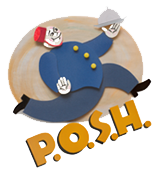Spode China was started in 1767 by Josiah Spode I, who became a visionary in business and in tableware. In the late 1700s, the popular chinaware from the Orient was becoming scarcer and Britain needed new sources for their dinnerware needs. Josiah Spode answered the call.
The Spode factory, under the careful guidance of Josiah, was responsible for two of the most important breakthroughs in English ceramics: first, the formula for bone china that is used today and, even more importantly, he perfected the "underglaze" printing process that is practiced to this day. Many intricate patterns could be applied to pieces without the worries of chipping, scratching and fading.
Delightfully little has changed since the Spode company first began producing English pottery in the 1700s. Its factory, still located in Stoke-on-Trent, is in operation today, and its methods of production have been modified only slightly. Transferware patterns continue to be created with handcrafted copper plates and hand-rubbed transfer sheets, and the earthenware is still made with ingredients that have been used since 1820.
Purchased by William Copeland and Thomas Garrett in 1833, the Spode mark was officially changed to Copeland Spode, the particular markings on this china.
